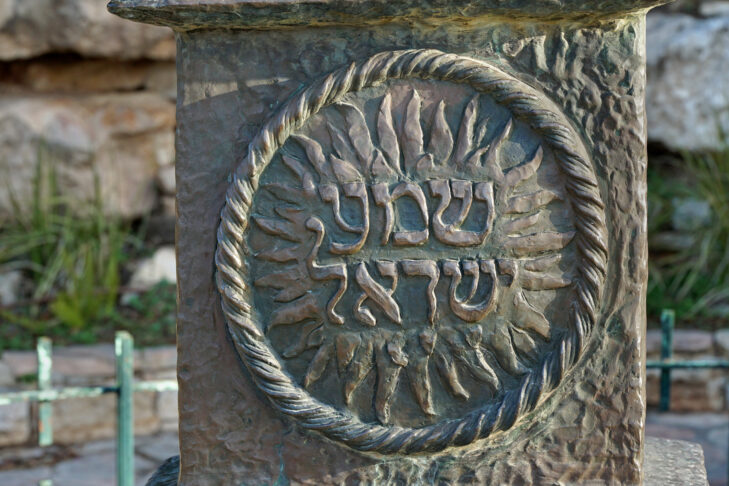This article originally appeared on The Jewish Experience, Brandeis University’s website devoted to Jewish issues. Subscribe to the monthly newsletter.
Shema Yisrael, or the Shema, is the central affirmation of Judaism.
The prayer expresses belief in the singularity of God, that is, in God’s oneness and incomparability.
It is traditionally recited twice a day, as part of the morning (Shacharit) and evening (Arvit or Ma’ariv) services.
It serves as the climax of the liturgy on Yom Kippur, the holiest day of the Jewish year. Jews often recite the prayer as their dying words, including Jewish martyrs who, throughout the ages, made it their final profession of faith before being put to death.
Brandeis University professor of classical rabbinic literature Reuven Kimelman said the Shema summons Jews to feel “an all-consuming love of God.”
“It’s a love that is unreserved, all-demanding, at all times, in all places and in all circumstances,” he said. “Nothing is excluded. Thoughts are to be focused, words are to be spoken, and deeds are to be done.”
The prayer dates from the first millennium B.C.E. when it was recited as part of regular services in the ancient temple in Jerusalem. It consists of three separate passages taken from the Hebrew Bible: Deuteronomy (6:4–9 and 11:13-21) and Numbers (15:37-41).
Below, Kimelman, a leading scholar on the Jewish liturgy, provides a translation and line-by-line analysis of the first passage, which is the best known.
Hear (Shema) Israel! the Lord is our God, the Lord is one.
Though this opening verse is now taken as the ultimate affirmation of monotheism, it seems likely that the ancient Israelites originally saw it as a declaration of monolatry.
Monotheism holds that there is only one God for all peoples, in this case, the God of the Hebrew Bible. Monolatry recognizes that there are other gods, but that the Israelites believe in the God of the Hebrew Bible.
In the Talmud, a compendium of rabbinical commentaries gathered between 200 and 500 C.E., the rabbis offered a new interpretation of this verse. They wrote, “the Lord is our God” applies to the present and “the Lord is one” to the future.
The idea is that Jews are the ones who acknowledge God in the present, while in the future, the hope is that all humanity will. Thus, the verse is seen as promoting universal monotheism, not monolatry, an interpretation that stuck forever after.
You shall love the Lord your God with all your heart (leiv), with all your soul (nephesh), and with all your utmost (me’od).
This verse is a threefold demand to love God. It serves as the opening for a miniature manual on the art of loving. Acting out the behaviors of love promotes the corresponding feelings of love. Going through the motions fosters the corresponding emotions.
Looking at each part of the verse separately:
with all your heart (leiv)
In the Bible, leiv can refer to both thought and feeling, so “with all your leiv” entails being totally mindful of God’s teachings and accepting them wholeheartedly or unreservedly. By using a single term for thought and feeling, both mind and emotion are enlisted in an all-consuming love.
with all your soul (nephesh)
Possessing both biological and psychological elements, nephesh in the Bible constitutes the self or one’s life force. “All your nephesh” goes even further than just the self, connecting to the “children” mentioned later in the prayer.
The expression thus connotes a personhood that includes one’s self and one’s progeny.
with all your utmost (me’od)
Me’od has a double meaning here.
First, it means “might,” suggesting you must love the Lord with all your strength. Second, it connotes “financial means,” suggesting you must love the Lord with all your wealth and possessions.
Inculcate them in your children by reciting them while at home and away, when lying down and when getting up.
This is the basis for saying the Shema twice daily.
Bind them as a sign on your arm and let them serve as a symbol on your forehead.
This verse refers to tefillin (phylacteries), small leather boxes with straps that Jews wear during prayer. They are placed on the upper arm across from the heart and on the head between the eyes. The boxes contain parchment scrolls with verses from the Shema in Hebrew (along with other biblical paragraphs that mention tefillin).
Tefillin connect to the meaning of me’od as “might.” Symbolically, tefillin are a means of harnessing one’s might—physically (on the arm), emotionally (in the heart) and intellectually (between the eyes).
It somewhat follows the model of Exodus 13:9 and 16, where the tefillin worn on the hand evokes God’s mighty hand delivering the Israelites from bondage in Egypt.
Inscribe them on the doorposts of your house and on your gates.
This is a reference to the mezuzah, decorative cases Jews post on the doorposts of their homes. The verses in the Shema taken from Deuteronomy are written on parchment inside.
A mezuzah connects to the meaning of me’od as “financial means.” The home is the quintessential possession and financial investment. The Shema commands that it be dedicated to the love of God as symbolized by the mezuzah.
This post has been contributed by a third party. The opinions, facts and any media content are presented solely by the author, and JewishBoston assumes no responsibility for them. Want to add your voice to the conversation? Publish your own post here. MORE



